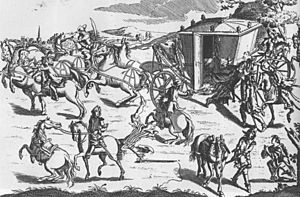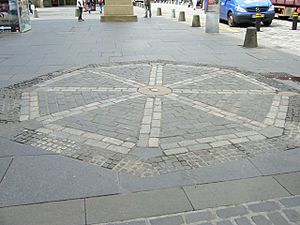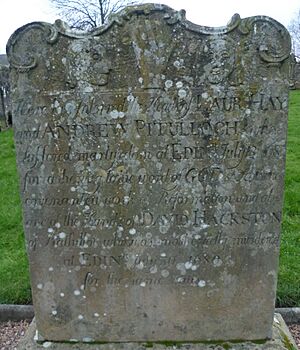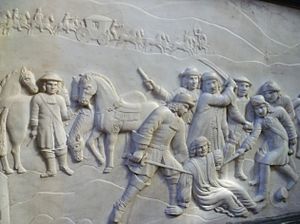David Hackston facts for kids
Quick facts for kids
David Hackston or Halkerstone
|
|
|---|---|
| Born | Rathillet, in the parish of Kilmany, Fife |
| Died | 30 July 1680 (executed) Grassmarket, Edinburgh |
| Buried | |
| Allegiance | |
| Battles/wars | Battle of Drumclog, Battle of Bothwell Bridge |

David Hackston or Halkerstone (died 30 July 1680) was a strong Scottish Covenanter. He is mostly remembered for his part in the death of Archbishop James Sharp of St. Andrews in 1679. He was also involved in events in 1680 that led to his capture and being put to death.
Contents
Who Was David Hackston?
Hackston came from a well-known landowning family. They were the Hackstons or Halkerstones of Rathillet in Fifeshire. He was the oldest son of James Hackston and Margaret Falconer. David took over his father's estate in 1670.
There is no sign that he was very religious when he was young. But he went to a "field preaching" event. This was a religious meeting held outdoors. After this, he decided to join the Covenanters. He became one of their most trusted leaders.
The Covenanters
The Covenanters were a Scottish religious and political movement. They supported a type of Protestantism called Presbyterianism. They believed the King should not control the Church. They signed "Covenants" to promise their faith. This led to conflicts with the government.
Involvement in Key Events
In 1679, David Hackston was asked to lead a group. This group wanted to kill Archbishop Sharp. Hackston refused to lead because he had a personal disagreement with Sharp. He felt Sharp had wronged him in a legal case. He did not want people to think he acted out of revenge.
However, Hackston agreed to stand by the group. He would accept whatever happened. So, he stayed a short distance away. Other members of the group, led by John Balfour of Kinloch, killed Sharp on May 3, 1679.
One person in the group, James Russell, later said something interesting. Sharp's servant came to Hackston, who was on horseback. He asked Hackston to help save Sharp's life. Hackston replied that he did not get involved in their actions. He also said he could not speak for or against them.
After the Archbishop's Death
After Sharp's death, Hackston went into hiding. He helped write a document called The Declaration and Testimony. This document criticized the government's actions. It spoke out against how the government handled religious matters. This was especially true since the King returned to the throne in 1660. This return is known as the Restoration.
On May 29, 1679, Hackston and other Covenanters rode into Rutherglen. This day was meant to celebrate the King's return. The Covenanters put out a bonfire in the main street. They read their Declaration in public. Then they attached it to the mercat cross. A new fire was lit. Acts of Parliament and the Privy Council against Covenanters were burned.
Battles and Capture
Hackston was also a leader for the Covenanters in two battles. He fought at the battle of Drumclog on June 1. He also fought at Bothwell Bridge on June 22, 1679. At Bothwell Bridge, he bravely defended the bridge. He held it for about an hour against stronger forces. These forces were led by the Duke of Monmouth.
Hackston escaped from the battlefield. A large reward of 10,000 merks was offered for his capture. This forced him to stay hidden.
In July 1680, he appeared again. He was with Richard Cameron and his armed followers. They were present when the Sanquhar Declaration was announced. This was another strong statement against the government.
Finally, on July 22, 1680, Hackston and about 60 followers were surprised. A group of soldiers called dragoons found them at Airds Moss in Ayrshire. A fight broke out. The Covenanters were defeated. Hackston was badly hurt. He was taken prisoner and brought to Edinburgh.

David Hackston was put to death on July 30, 1680.
Memorials
In the old churchyard at Cupar, there is a tombstone. It remembers three people who suffered for the Covenant. The stone says:
"Here lie interred the heads of Laur Hay : and Andrew Pitulloch, who suffered martyrdom at Edinburgh, July 13th, 1681, for adhering to the word of God, and Scotland's covenanted work of reformation ; and also one of the hands of David Hackston, of Rathillet, who was most cruelly martyred at Edinburgh, July 30th, 1680.
Our persecutors filled with rage,
Their brutish fury to assuage,
Took heads and hands of martyrs off,
That they might be the people's scoff.
They Hackston's body cut asunder,
And set it up a world's wonder
In several places; to proclaim
These monsters' glory and their shame."




